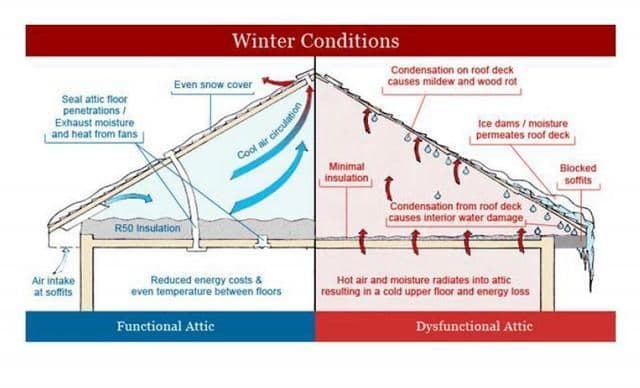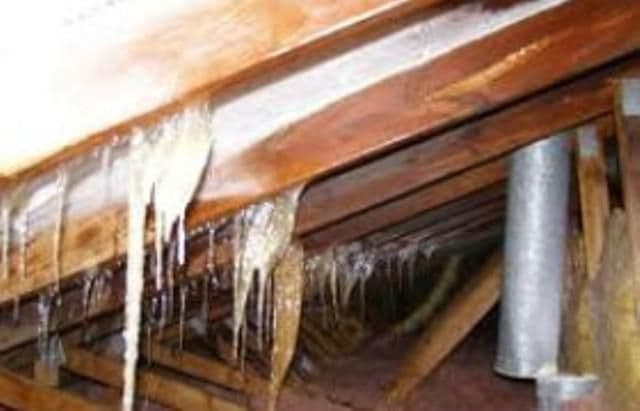Attic Ventilation During Cold Weather
When winter arrives and temperatures plunge, you might think the movement of heated air would no longer cause problems in attics. But that's not true. With seasonal changes, the conditions just reverse. Heat doesn't travel from an attic into the living quarters. Instead, heated indoor air travels from the home into the attic - along with moisture. The image below illustrates how this process of moisture transfer takes place:

Furnace-warmed air circulates through the house, picking up water vapor generated by activities such as cooking, bathing, and the washing of clothes and dishes. The use of humidifiers, common in many homes, provides an abundant and continual source of moisture. Keep in mind also that the warmer the air is, the greater its capacity to hold moisture.
The problem is especially acute in homes with electric heating. Most of these homes were built since the mid-1970's, using advanced insulation materials and methods. As a result, most are "tight," allowing minimal infiltration of outside air. In addition, electric heat sources do not require air for combustion, so another common source of outdoor air has been eliminated. The positive side of these super-insulated homes is, of course, the greater energy efficiency. But because cooler, drier outdoor air is kept out, the indoor air holds greater amounts of moisture.
Problems arise when the warm, moist air from the living quarters moves toward the attic, where the air is cooler and drier. That moist air is drawn to the attic in two ways. The first is through a process called "vapor diffusion." It's a process in which water vapor naturally travels from high-humidity conditions to low-humidity conditions - in our example - from the living quarters into the attic. The force of vapor diffusion is so great that moisture even travels through building materials such as sheet rock.
Even vapor barriers, for all their effectiveness, cannot totally stop this process. The second way moisture travels into an attic is by air moving through openings cut into a vapor barrier. Such openings are commonly found, for example, at recessed ceiling boxes and attic entries.
The problems start when moist air hits cooler rafters, trusses and roof sheathing. The moisture condenses as water droplets or frost. Eventually, the condensation drips on the insulation below. If too much water soaks into the insulation, its volume can be compressed and its effectiveness reduced. The sequence of events that follows is predictable; greater heat loss leads to colder rooms, colder rooms lead to a greater need for heat, greater use of the furnace leads to higher energy bills.

But that's only the immediate problem and its consequences. As with heat buildup, moisture buildup has long-term effects. That's because not all the condensing moisture drips into insulation. The structural elements of the house absorb some, leading to wood rot and the deterioration of roofing materials. Other moisture is likely to soak into the attic floor and eventually into ceiling materials, causing water stains and paint damage in the rooms below.
We hope after reading this, you will understand why proper attic ventilation is extremely important when it comes to protecting your roofing system and your home.
If you would like to know more, or would like us to evaluate your current attic ventilation as part of your roofing system, please visit our website and schedule an appointment online: www.precisionroofingmi.com.
Our professional roofing consultants will be happy to stop by and take a look at your attic in order to provide you with any recommendations and a quote. There is no charge for the appointment or the quote.
Prices are rising—lock in your roof at 2025 rates now with 12% off new roof and "BOGO" Free gutter protection when you purchase new Gutters.
Recent Posts
Many of our customers ask us why we need to look in to the attic in order to provide a quote? What does attic ventilation...
It can be distressing to discover issues with your roofing system, particularly if you are experiencing a leak. A leaking roof is a serious issue and must be addressed promptly....
Maintaining Gutters is a very important task...
What to look for in a roof when buying a house...
Get A Free Estimate Today!
Contact us today to receive a free, no-obligation estimate for your quality home renovations!

Offers For You
At Precision Roofing Services, we’re here to serve you—for years to come. That includes standing behind all of our work with generous warranties! Call our Greater Lansing team today for more information and a free quote.
Budgeting is easier with our flexible financing options that include low interest rates and low monthly payments.
Premium Roofing Services
Mon-Fri: 8:00 AM-7:30 PM
Sat: 9:00 AM-12:30 PM
Sun: Closed


